Why did the picture-book illustrators grumble about drawing a certain animal?! by Paeony Lewis
In a picture book it’s easy to write Twenty-nine ancient elephants jumped over the dancing ladybirds. Or even Three smelly dinosaurs munched a castle built of diamonds and opals. But what of the illustrators? It’s not so easy for them! That’s why I tried to be really careful about the unpublished picture-book text I picked for two illustrators who were scheduled to perform a fast-paced ‘Sketching Duel’.
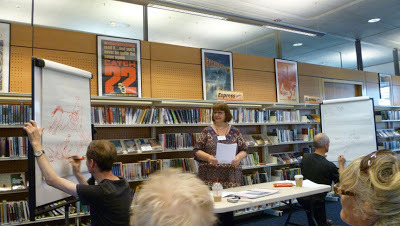 Sketching Duel: John Shelley (Paeony Lewis) Mike BrownlowThe live sketching event was to be in front of an audience at the Millennium Library in Norwich (the most popular public library in the UK). It was part of a day of writing and illustration activities organised by the Eastern Branch of the SCBWI* to accompany an exhibition of members’ illustrations.
Sketching Duel: John Shelley (Paeony Lewis) Mike BrownlowThe live sketching event was to be in front of an audience at the Millennium Library in Norwich (the most popular public library in the UK). It was part of a day of writing and illustration activities organised by the Eastern Branch of the SCBWI* to accompany an exhibition of members’ illustrations.
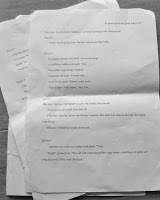 Even for professional illustrators, the 'Sketching Duel' was quite a challenge. The illustrators weren't allowed to read the text beforehand, and each double-page spread was to be read out in turn, and a rough illustration drawn in mere in minutes. Yikes, don’t blame me, I didn't make the rules! So I chose one of my picture-book texts that had a very simple, traditional structure and no over-the-top scenes. What could possibly go wrong?
Even for professional illustrators, the 'Sketching Duel' was quite a challenge. The illustrators weren't allowed to read the text beforehand, and each double-page spread was to be read out in turn, and a rough illustration drawn in mere in minutes. Yikes, don’t blame me, I didn't make the rules! So I chose one of my picture-book texts that had a very simple, traditional structure and no over-the-top scenes. What could possibly go wrong?
The two professional illustrators were: John Shelley and Mike Brownlow.
John draws all sorts of things…
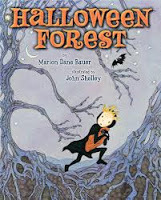
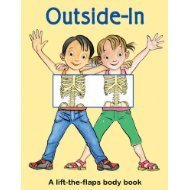
Mike draws all sorts of things…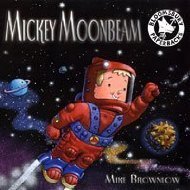

So with two flipcharts and an expectant audience, we began. I told them the story was about a horse named Ivor.
A HORSE?!!
Yup, a horse. Not so bad? Ho hum, it seems I could ask them to draw penguins or dinosaurs or humans or bunnies or anything EXCEPT horses! But it was too late. It was horses.
As I've said, John and Mike are professionals, so they began. Reluctantly…
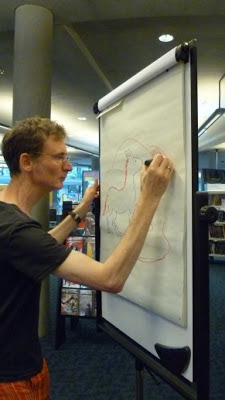 John Shelley drawing Ivor the horse
John Shelley drawing Ivor the horse
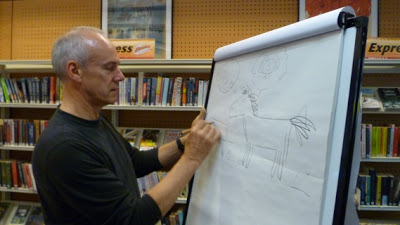 Mike Brownlow
Mike Brownlow
In this image Mike has given Ivor the horse a thought bubble containing a child. Oops, I hadn’t explained that the other character, Little Nelly, was a foal, not a human. We writers sometimes forget that although we know the story inside out, the reader/illustrator doesn't.
Of course, despite my unintended attempts to thwart the illustrators with horses, they didn't turn away from the challenge and went on to produce delightful images that reflected and added to the story. Here are a few they drew in mere moments, with a snippet of the story (not all their images were so similar).
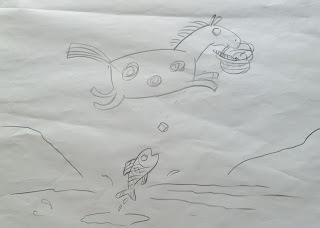
Above Mike, below John.
Story snippet: Clip clop, clip clop, Ivor trots on until he sees a wide river. He jumps.
“Whee! Oops!”
Splosh! The golden sugar lumps plop into the mouth of a huge salmon. “Yummy.”

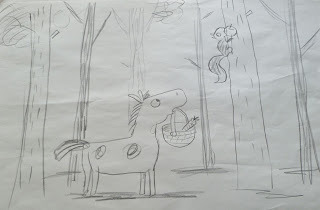
Above Mike, below John.
Story snippet: Clip clop, clip clop, Ivor trots through towering trees.
Shadows move and out bursts a sneaky squirrel.
It grabs the dazzling red apple and dashes up a pine tree.
“Yummy yum!”
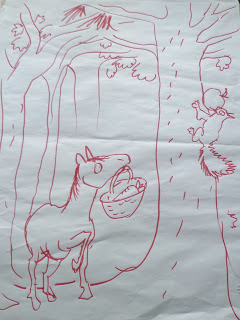
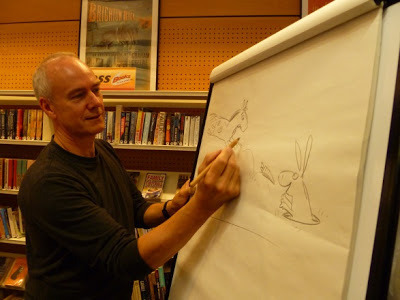 Is Mike smiling because he was allowed to draw a bunny?!
Is Mike smiling because he was allowed to draw a bunny?!
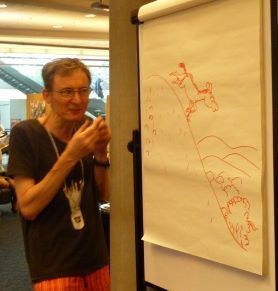 John explained how an illustrator can hint at something that has happened, without actually drawing it. Here, Ivor the horse runs up the hill, and then begins running down. Hoof prints are the clue that he has already run up.
John explained how an illustrator can hint at something that has happened, without actually drawing it. Here, Ivor the horse runs up the hill, and then begins running down. Hoof prints are the clue that he has already run up.
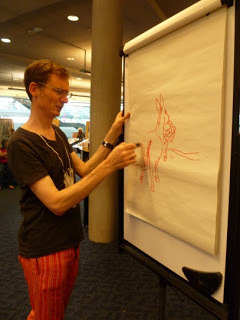 Whilst here, I asked John why he’d drawn the rear of Ivor. John explained that illustrators sometimes do this to show a transition scene. It’s an illustrative way to show the story is moving on to something new. It also gives a sense of anticipation.
Whilst here, I asked John why he’d drawn the rear of Ivor. John explained that illustrators sometimes do this to show a transition scene. It’s an illustrative way to show the story is moving on to something new. It also gives a sense of anticipation.
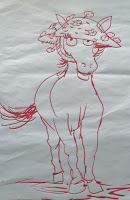 John ShelleyFinally, here are the last pages, and I was intrigued how the horses had developed over the twelve illustrations. When I asked how illustrators decide on whether to use a cartoon or realistic style, the illustrators explained it often depended on the story. The more anthropomorphic a story, the more a story is likely to need cartoon illustrations because a realistic horse would look ‘wrong’ doing human-like actions.
John ShelleyFinally, here are the last pages, and I was intrigued how the horses had developed over the twelve illustrations. When I asked how illustrators decide on whether to use a cartoon or realistic style, the illustrators explained it often depended on the story. The more anthropomorphic a story, the more a story is likely to need cartoon illustrations because a realistic horse would look ‘wrong’ doing human-like actions.
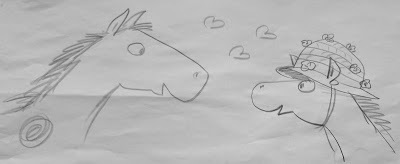 Mike Brownlow
Mike Brownlow
As somebody who writes, and doesn't illustrate, I was blown away by John and Mike’s fast, unprepared sketches. I also learnt new things about the way words and illustrations combine. However, I still didn't understand what it was about horses that made them cringe. So later I asked them.
Mike Brownlow
“I draw in a stylised, cartoony sort of way, and I think part of the reason I don't like drawing horses is that they're almost impossible to draw standing up. Everyone's idea of a horse is of an animal on four legs. But the really popular children's book animals such as bears, penguins, dogs, cats, rabbits and pigs can all be made to act as substitute humans by putting them on two legs instead of four. It's really tricky to do that with a horse. I can't honestly think of an example of one in popular children's literature apart from Black Beauty. That was a very naturalistic story, though, and horses were drawn realistically. In the modern picture book era, I can't think of one. Can anyone else? Maybe it's the long face. Cue old joke.”
John Shelley
“What's the problem with drawing horses? I actually like drawing horses when I have plenty of time, but conjuring a horse character straight out of your mind can be more of a challenge!
Some animals can be distorted or simplified and still read correctly – draw a furry body with heavy haunches - add long ears and it will be read as a rabbit. Same figure with pointier nose, round ears and a long tail - you've got a mouse. Horses though have clearly defined front/middle/rear proportions, and look awkward if you stand them on two legs. Lack of hands or paws makes it difficult for them to gesture. Then there's that big long face with small eyes! A challenge, but not impossible! I’m a great admirer of Norman Thelwell’s work, a brilliant artist who really knew how to instil character into a horse.”
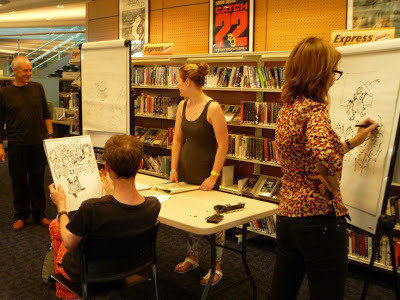
At the end of the day of events, another SCBWI member and writer, Annie Neild, read out one of her picture book texts. This time John used charcoal instead of red highlighter pen (a frustrating medium). Mike stuck with pencil. Plus another professional illustrator was able to take part, Bridget Strevens-Marzo. Juggling pandas, giraffes, lions and crocodiles were all illustrated! Everyone was happy… NO HORSES!
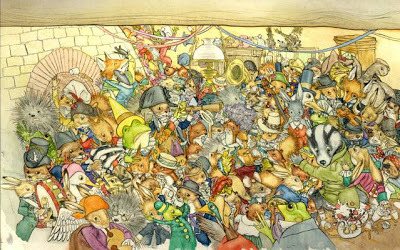 Look what I've found:
Look what I've found:
a multitude of small animals, and no horses, in this lovely illustration
by John Shelley (Japanese book: Hoppy's New House)
************** You can find out more at our websites:
Blog by children's author, Paeony Lewis www.paeonylewis.com
Mike Brownlow www.mikebrownlow.comJohn Shelley www.jshelley.com/Bridget Strevens-Marzo www.bridgetstrevens.com/*SCBWI Society of Children's Book Writers and Illustrators (British Isles) www.britishscbwi.org/
 Sketching Duel: John Shelley (Paeony Lewis) Mike BrownlowThe live sketching event was to be in front of an audience at the Millennium Library in Norwich (the most popular public library in the UK). It was part of a day of writing and illustration activities organised by the Eastern Branch of the SCBWI* to accompany an exhibition of members’ illustrations.
Sketching Duel: John Shelley (Paeony Lewis) Mike BrownlowThe live sketching event was to be in front of an audience at the Millennium Library in Norwich (the most popular public library in the UK). It was part of a day of writing and illustration activities organised by the Eastern Branch of the SCBWI* to accompany an exhibition of members’ illustrations.  Even for professional illustrators, the 'Sketching Duel' was quite a challenge. The illustrators weren't allowed to read the text beforehand, and each double-page spread was to be read out in turn, and a rough illustration drawn in mere in minutes. Yikes, don’t blame me, I didn't make the rules! So I chose one of my picture-book texts that had a very simple, traditional structure and no over-the-top scenes. What could possibly go wrong?
Even for professional illustrators, the 'Sketching Duel' was quite a challenge. The illustrators weren't allowed to read the text beforehand, and each double-page spread was to be read out in turn, and a rough illustration drawn in mere in minutes. Yikes, don’t blame me, I didn't make the rules! So I chose one of my picture-book texts that had a very simple, traditional structure and no over-the-top scenes. What could possibly go wrong?The two professional illustrators were: John Shelley and Mike Brownlow.
John draws all sorts of things…


Mike draws all sorts of things…


So with two flipcharts and an expectant audience, we began. I told them the story was about a horse named Ivor.
A HORSE?!!
Yup, a horse. Not so bad? Ho hum, it seems I could ask them to draw penguins or dinosaurs or humans or bunnies or anything EXCEPT horses! But it was too late. It was horses.
As I've said, John and Mike are professionals, so they began. Reluctantly…
 John Shelley drawing Ivor the horse
John Shelley drawing Ivor the horse Mike Brownlow
Mike BrownlowIn this image Mike has given Ivor the horse a thought bubble containing a child. Oops, I hadn’t explained that the other character, Little Nelly, was a foal, not a human. We writers sometimes forget that although we know the story inside out, the reader/illustrator doesn't.
Of course, despite my unintended attempts to thwart the illustrators with horses, they didn't turn away from the challenge and went on to produce delightful images that reflected and added to the story. Here are a few they drew in mere moments, with a snippet of the story (not all their images were so similar).

Above Mike, below John.
Story snippet: Clip clop, clip clop, Ivor trots on until he sees a wide river. He jumps.
“Whee! Oops!”
Splosh! The golden sugar lumps plop into the mouth of a huge salmon. “Yummy.”


Above Mike, below John.
Story snippet: Clip clop, clip clop, Ivor trots through towering trees.
Shadows move and out bursts a sneaky squirrel.
It grabs the dazzling red apple and dashes up a pine tree.
“Yummy yum!”

 Is Mike smiling because he was allowed to draw a bunny?!
Is Mike smiling because he was allowed to draw a bunny?! John explained how an illustrator can hint at something that has happened, without actually drawing it. Here, Ivor the horse runs up the hill, and then begins running down. Hoof prints are the clue that he has already run up.
John explained how an illustrator can hint at something that has happened, without actually drawing it. Here, Ivor the horse runs up the hill, and then begins running down. Hoof prints are the clue that he has already run up. Whilst here, I asked John why he’d drawn the rear of Ivor. John explained that illustrators sometimes do this to show a transition scene. It’s an illustrative way to show the story is moving on to something new. It also gives a sense of anticipation.
Whilst here, I asked John why he’d drawn the rear of Ivor. John explained that illustrators sometimes do this to show a transition scene. It’s an illustrative way to show the story is moving on to something new. It also gives a sense of anticipation. John ShelleyFinally, here are the last pages, and I was intrigued how the horses had developed over the twelve illustrations. When I asked how illustrators decide on whether to use a cartoon or realistic style, the illustrators explained it often depended on the story. The more anthropomorphic a story, the more a story is likely to need cartoon illustrations because a realistic horse would look ‘wrong’ doing human-like actions.
John ShelleyFinally, here are the last pages, and I was intrigued how the horses had developed over the twelve illustrations. When I asked how illustrators decide on whether to use a cartoon or realistic style, the illustrators explained it often depended on the story. The more anthropomorphic a story, the more a story is likely to need cartoon illustrations because a realistic horse would look ‘wrong’ doing human-like actions.
 Mike Brownlow
Mike BrownlowAs somebody who writes, and doesn't illustrate, I was blown away by John and Mike’s fast, unprepared sketches. I also learnt new things about the way words and illustrations combine. However, I still didn't understand what it was about horses that made them cringe. So later I asked them.
Mike Brownlow
“I draw in a stylised, cartoony sort of way, and I think part of the reason I don't like drawing horses is that they're almost impossible to draw standing up. Everyone's idea of a horse is of an animal on four legs. But the really popular children's book animals such as bears, penguins, dogs, cats, rabbits and pigs can all be made to act as substitute humans by putting them on two legs instead of four. It's really tricky to do that with a horse. I can't honestly think of an example of one in popular children's literature apart from Black Beauty. That was a very naturalistic story, though, and horses were drawn realistically. In the modern picture book era, I can't think of one. Can anyone else? Maybe it's the long face. Cue old joke.”
John Shelley
“What's the problem with drawing horses? I actually like drawing horses when I have plenty of time, but conjuring a horse character straight out of your mind can be more of a challenge!
Some animals can be distorted or simplified and still read correctly – draw a furry body with heavy haunches - add long ears and it will be read as a rabbit. Same figure with pointier nose, round ears and a long tail - you've got a mouse. Horses though have clearly defined front/middle/rear proportions, and look awkward if you stand them on two legs. Lack of hands or paws makes it difficult for them to gesture. Then there's that big long face with small eyes! A challenge, but not impossible! I’m a great admirer of Norman Thelwell’s work, a brilliant artist who really knew how to instil character into a horse.”

At the end of the day of events, another SCBWI member and writer, Annie Neild, read out one of her picture book texts. This time John used charcoal instead of red highlighter pen (a frustrating medium). Mike stuck with pencil. Plus another professional illustrator was able to take part, Bridget Strevens-Marzo. Juggling pandas, giraffes, lions and crocodiles were all illustrated! Everyone was happy… NO HORSES!
 Look what I've found:
Look what I've found: a multitude of small animals, and no horses, in this lovely illustration
by John Shelley (Japanese book: Hoppy's New House)
************** You can find out more at our websites:
Blog by children's author, Paeony Lewis www.paeonylewis.com
Mike Brownlow www.mikebrownlow.comJohn Shelley www.jshelley.com/Bridget Strevens-Marzo www.bridgetstrevens.com/*SCBWI Society of Children's Book Writers and Illustrators (British Isles) www.britishscbwi.org/
Published on August 09, 2013 00:00
No comments have been added yet.



